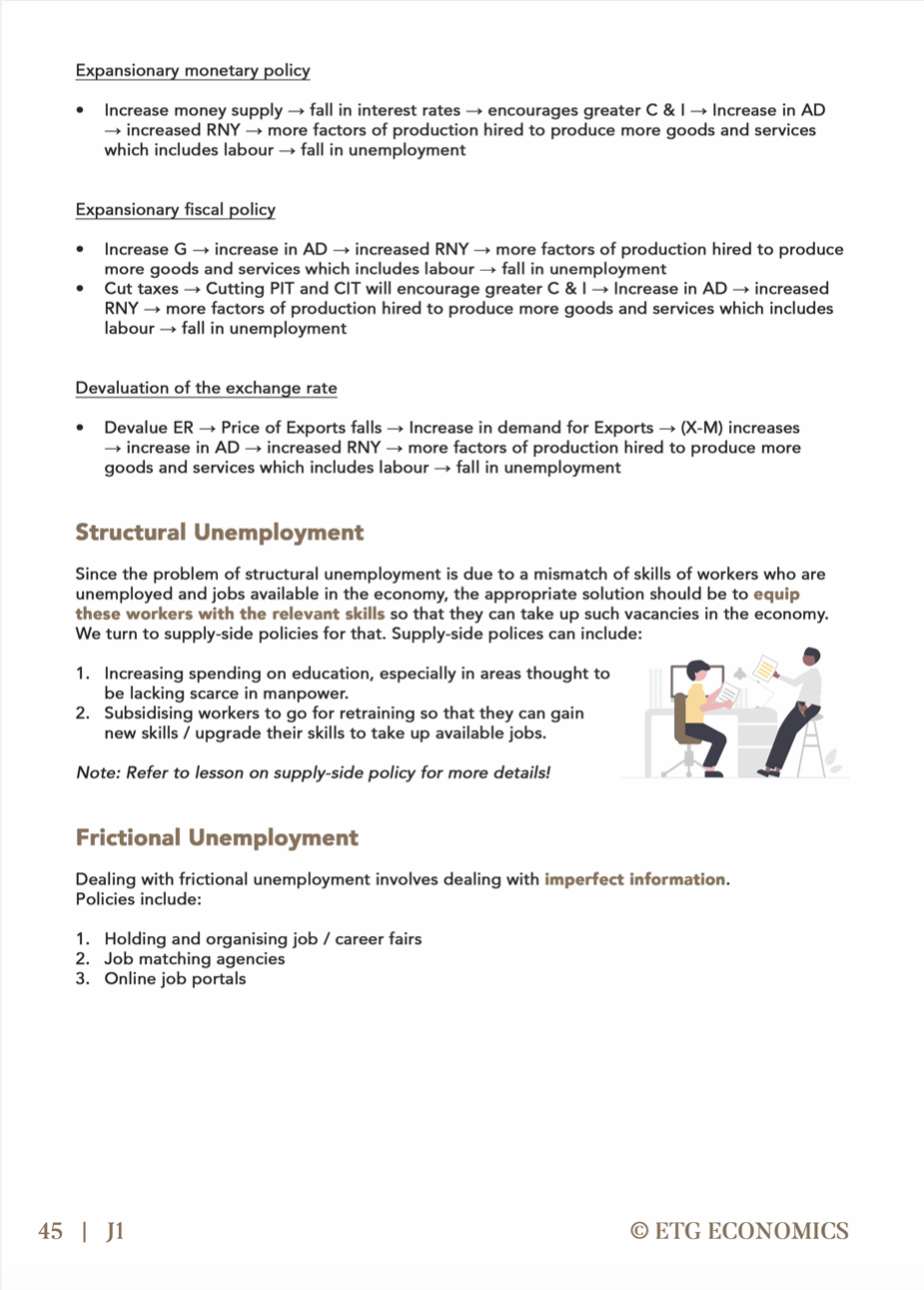Unemployment
Unemployment is a critical concept in economics, affecting both individuals and the wider economy. It refers to the condition where people who are capable of working and actively looking for a job cannot find work. Unemployment is not just a personal issue—it has broader economic implications. High levels of unemployment can harm economic growth, increase government spending on social benefits, and create social problems. On the other hand, low unemployment often signals a thriving economy, where most people who want a job can find one.
For students in economics tuition Singapore or any economics tuition centre, understanding unemployment is fundamental to understanding the functioning of any economy.
Types of Unemployment
There are different types of unemployment that arise for various reasons. These include demand-deficient, structural, and frictional unemployment.
Demand-Deficient Unemployment
Demand-deficient unemployment occurs when there is insufficient demand for goods and services in the economy. When demand falls, businesses produce less, and as a result, they may lay off workers. This type of unemployment is most common during periods of economic recession.
Causes:
Low Aggregate Demand (AD): A reduction in consumer spending, business investment, or government spending leads to lower overall demand for goods and services.
Recession: When the economy shrinks, firms often reduce their workforce to cope with the lack of demand for their products and services.
Real-World Example: During the 2008 global financial crisis, the U.S. and many European countries experienced a sharp fall in consumer demand. This led to widespread demand-deficient unemployment, as businesses downsized or closed due to reduced sales and investments. For students learning A Level economics tuition, understanding how recessions lead to this type of unemployment is key.
Structural Unemployment
Structural unemployment arises when there is a mismatch between the skills of the workforce and the jobs available. As industries evolve, workers may find that their skills are no longer in demand.
Causes:
Technological Changes: The advancement of technology can make certain jobs obsolete, leading to unemployment. For example, automation in manufacturing has replaced many low-skill jobs.
Globalization: The outsourcing of jobs to countries with cheaper labor forces can lead to job losses in high-wage countries.
Industry Shifts: Some industries, like coal mining, have declined, while others, like IT and renewable energy, have grown.
Real-World Example: In the UK, the decline of the coal mining industry in the 1980s led to high levels of structural unemployment in coal-dependent areas. As new industries emerged, workers were left without the skills to transition to these sectors.
Frictional Unemployment
Frictional unemployment occurs when individuals are temporarily out of work while transitioning between jobs or entering the labor force for the first time.
Causes:
Job Switching: People leave their current job to find a better opportunity, leading to short-term unemployment as they search for new work.
New Graduates: Students entering the labor market for the first time often experience frictional unemployment while they look for their first job.
Seasonal Employment: Jobs that are only available at certain times of the year (like in tourism or agriculture) may lead to temporary unemployment between seasons.
Real-World Example: Graduates from universities in countries like the U.S. and UK experience frictional unemployment as they look for jobs that match their qualifications. While this is a normal part of entering the job market, it can still be frustrating.
Consequences of Unemployment
Unemployment has both economic and social consequences that can affect individuals, businesses, and society as a whole.
Economic Consequences
Reduced Economic Output: When people are unemployed, they do not contribute to the production of goods and services. This reduces the overall output of the economy.
Lower Tax Revenues: Unemployed individuals do not pay taxes, reducing government revenues. This can lead to a budget deficit.
Increased Government Spending: Governments often need to provide unemployment benefits or welfare payments to those who are out of work, which increases public spending.
Social Consequences
Mental Health Issues: Unemployment can cause stress, anxiety, and depression, particularly if the unemployment is prolonged.
Increased Crime Rates: High unemployment can lead to social unrest and higher crime rates, especially among younger, unemployed individuals.
Social Unrest: Prolonged unemployment can lead to protests and dissatisfaction with the government, which can destabilize society.
Long-Term Consequences
Hysteresis: When unemployment is high for an extended period, people may lose their skills, and their chances of finding employment decrease, even after the economy recovers.
Generational Unemployment: In some communities, unemployment becomes entrenched, and future generations experience higher rates of joblessness.
Indicators to Assess Unemployment
Measuring Unemployment:
Unemployment Rate = (Number of Unemployed People) / (Labor Force) x 100%
Natural rate of unemployment: The level of unemployment at which the inflation rate rises, which means that below this level of unemployment, inflation starts to rise. There is structural and frictional unemployment but little cyclical unemployment present. For large economies, a range of unemployment rates considered to be at full employment level would be 3 to 5% while for smaller economies it would be 2 to 3%.
Full employment level: There is a base level of unemployment to which we refer to as the natural rate of unemployment or NAIRU (non-accelerating inflationary rate of unemployment). This does NOT mean that there is 0% unemployment.
Unemployment in Singapore:
For the bulk of the last decade, Singapore’s unemployment rate largely hovered around 2 to 3%, operating either at full employment or near full employment level.
The peak unemployment rate of 3.2% was experienced in 2020 as a result of Covid-19 disruptions and only in mid-2021, it fell to about 2.8%.
As of Q1 2024, Singapore's seasonally adjusted unemployment rate is 2.1%, indicating a relatively low level of unemployment. This is slightly higher than the 2.0% rate observed in Q4 2023 but still considered healthy.
Policies to Solve Each Type of Unemployment
Demand-Deficient Unemployment Policies
To combat demand-deficient unemployment, governments can implement policies to increase demand in the economy.
Monetary Policy: Central banks may reduce interest rates to encourage businesses to invest and consumers to spend more.
Fiscal Policy: Governments may increase public spending, such as on infrastructure projects, to boost aggregate demand and create jobs.
Real-World Example: After the 2008 financial crisis, the U.S. government implemented large fiscal stimulus packages to reduce demand-deficient unemployment. These included government-funded projects to create jobs in infrastructure and public services.
Structural Unemployment Policies
To address structural unemployment, policies must focus on re-skilling workers and helping them transition to new industries.
Education and Training: Governments can invest in vocational education and training programs to help workers acquire new skills.
Subsidies for Research and Development: Supporting emerging industries can help create new jobs for workers whose skills are no longer in demand.
Labor Market Flexibility: Making it easier for workers to move between industries or regions can help reduce structural unemployment.
Real-World Example: Germany’s apprenticeship system helps young people gain skills in industries where there is high demand, reducing structural unemployment.
Frictional Unemployment Policies
For frictional unemployment, the aim is to reduce the time people spend between jobs.
Job Matching Services: Governments or private agencies can provide services to connect job seekers with suitable opportunities quickly.
Career Counseling: Providing guidance to individuals looking for work can help them make better decisions and find jobs faster.
Real-World Example: In Singapore, the Workforce Development Agency (WDA) provides job-matching services, helping individuals transition smoothly between jobs.
Conclusion
Unemployment is a significant macroeconomic issue with several causes and consequences. Understanding the different types of unemployment—demand-deficient, structural, and frictional—helps students studying A Level economics tuition to grasp how economies function and how governments manage these challenges. Policies aimed at addressing each type of unemployment, including monetary, fiscal, and training programs, are crucial in reducing unemployment and its negative effects on the economy and society.
By studying unemployment and its causes, students can better understand how economic policies are designed to promote employment and improve economic stability.
Discussion Questions
How do demand-deficient, structural, and frictional unemployment differ in terms of causes and policy responses?
What are the economic and social consequences of high unemployment in an economy?
How can governments use fiscal and monetary policies to reduce demand-deficient unemployment?
In what ways can education and training programs help address structural unemployment?
Why is youth unemployment a significant concern, and what specific policies can target this issue?
For students seeking top-tier economics tuition in Singapore, ETG Economics Tuition offers a specialized program tailored to meet the needs of A Level and IB Economics students. Led by Mr. Eugene Toh, who holds double Master's degrees and has been featured in various media outlets, ETG focuses on ensuring students are well-prepared for their exams with a comprehensive curriculum covering both content and real-world applications. With a proven track record of success, 71% of ETG's A Level Economics students achieved an 'A' grade in 2023, with over 90% from top junior colleges such as RI, HCI, NJC, and more. At ETG, students benefit from access to exclusive learning materials, including in-house publications, essays, and summaries developed by Mr. Toh and his academic team. Whether you prefer on-site classes in Bukit Timah, Marymount, or Bedok, or flexible online economics tuition, ETG offers a variety of learning options to suit your schedule. For those looking for A Level economics tuition, ETG’s program stands out due to its tailored approach to teaching. The weekly graded homework program with personalized feedback ensures that students can track their progress and fine-tune their skills. Additionally, students enjoy consultation opportunities with Mr. Toh, either in-person or via Zoom, at no extra charge. ETG also provides early registrants with exclusive access to premium resources like the Essay and CSQ Booster course, recorded lessons, and additional support. With its focus on exam preparation, including accurate exam predictions and intensive revision packages, ETG equips students for success. Whether you are preparing for your upcoming exams or seeking a headstart before advancing to JC2, ETG provides the ideal environment to achieve your academic goals.
Take a look at our stunningly curated textbooks, exclusively available for ETG students only:



